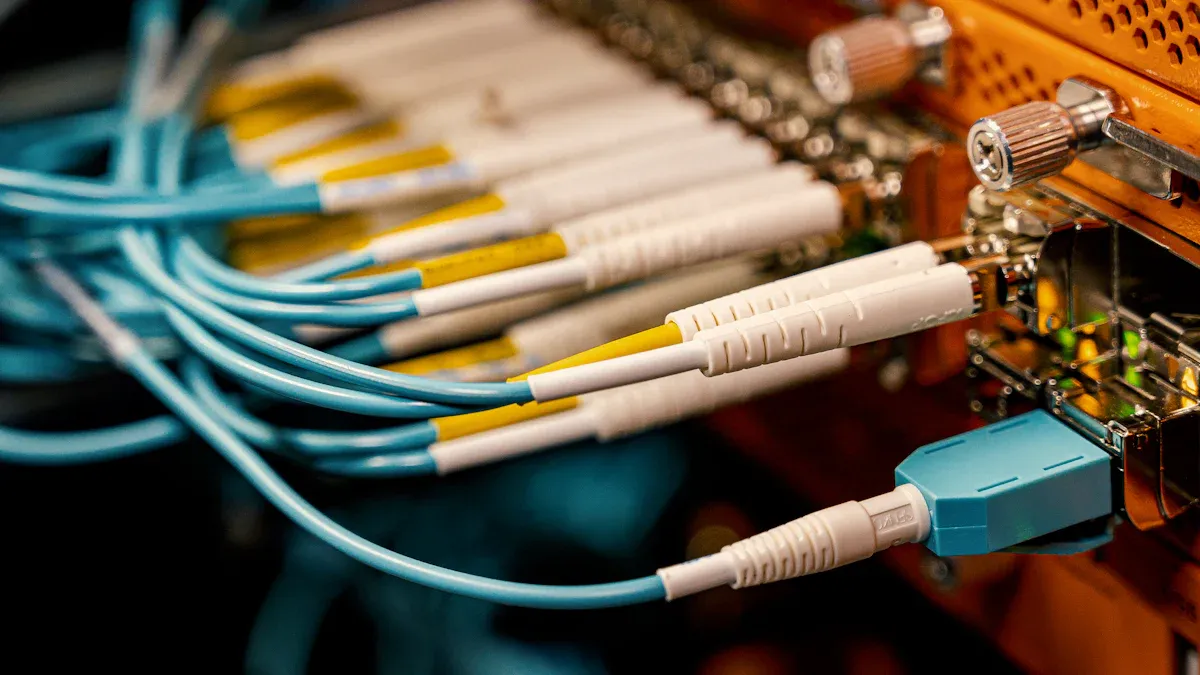

Coaxial cables have transformed how people communicate, making them a cornerstone of modern technology. These cables, developed in the 19th century by Oliver Heaviside, initially supported telegraph and telephone transmissions. Their importance grew with the rise of television broadcasting, as their shielding capabilities allowed for clearer signals. By 1940, the first coaxial-cable link transmitted 300 voice channels at 3 MHz. Over time, advancements in coaxial systems enabled data rates to reach 274 Mbit/s by 1975. This remarkable history and evolution demonstrate their enduring impact on communication systems.
Oliver Heaviside, a self-taught physicist, made groundbreaking contributions to the development of coaxial cables. His work in the 1880s laid the foundation for understanding signal transmission. He developed the Transmission Line Model, which explains how voltage and current behave along electrical lines. Heaviside also formulated the Telegraph Equations, which describe the behavior of electrical signals over time and distance. These equations built upon James Clerk Maxwell's theories of electromagnetism, further advancing the field.
| Contribution | Description |
|---|---|
| Transmission Line Model | Describes how voltage and current behave on electrical transmission lines. |
| Telegraph Equations | Explains the behavior of electrical signals over distance and time. |
| Foundation on Maxwell's Theories | Builds upon the earlier theories of electromagnetism established by James Clerk Maxwell. |
Heaviside's work provided the theoretical framework for the first coaxial structure, enabling engineers to design cables capable of efficient signal transmission.
The history of coaxial cables is closely tied to the early telegraph systems. The first transatlantic telegraph cable, constructed by the Atlantic Telegraph Company under Cyrus West Field's leadership, marked a significant milestone. Completed in 1858, it enabled communication between Europe and North America. Queen Victoria sent the first message to President James Buchanan, demonstrating the cable's potential. However, the cable failed after three weeks due to poor performance.
Despite this setback, the telegraph revolutionized communication. A study in the American Economic Review revealed that the telegraph boosted transatlantic trade and reduced prices, with efficiency gains estimated at 8 percent of export value. These early innovations paved the way for the development of coaxial cables, which offered improved reliability and efficiency.
Guglielmo Marconi, known as the father of wireless communication, also played a role in the history of coaxial cables. His experiments with radio waves in the late 19th and early 20th centuries demonstrated the potential of coaxial structures for transmitting signals over long distances. Marconi's work inspired further research into coaxial designs, leading to the first coaxial cable capable of supporting both telegraph and telephone transmissions. His contributions bridged the gap between early telegraph systems and modern communication technologies.
The invention of the modern coaxial cable marked a turning point in communication technology. Lloyd Espenschied and Herman Affel, working at AT&T's Bell Telephone Laboratories, patented the first recognizable coaxial cable in 1929. Their design addressed the limitations of earlier transmission methods, such as single-wire and two-wire lines, by introducing a structure that minimized signal interference.
| Year | Inventors | Organization |
|---|---|---|
| 1929 | Lloyd Espenschied, Herman Affel | AT&T's Bell Telephone Laboratories |
This innovation leveraged the principles of electromagnetic shielding to improve signal clarity and reliability. The coaxial cable's unique design, featuring a central conductor surrounded by an insulating layer and a metallic shield, allowed for high-frequency transmission over long distances. This breakthrough laid the foundation for the widespread adoption of coaxial cables in various industries.
Coaxial cables quickly found applications in telecommunication and broadcasting. In 1931, Espenschied and Affel's patented design enabled AT&T to develop systems capable of transmitting voice and data signals with unprecedented efficiency. By 1936, coaxial cables were used to broadcast images from the Berlin Olympics, showcasing their potential in high-bandwidth applications.
| Year | Event Description |
|---|---|
| 1880 | Oliver Heaviside studies the skin effect and patents the first coaxial cable. |
| 1884 | Siemens & Halske registers a similar patent. |
| 1931 | Lloyd Espenschied and Herman Affel patent the first recognizable coaxial cable for AT&T. |
| 1936 | Coaxial cable is used to transmit images from the Berlin Olympics, marking a significant milestone in broadcasting technology. |
In the 1950s, Bell Telephone Laboratories developed transatlantic coaxial cable systems, including the TAT-1 cable, which connected Europe and the United States. These systems significantly enhanced communication capacity, enabling faster and more reliable international transmissions. Additionally, submarine coaxial cables, such as the one laid between Florida and Havana, demonstrated the versatility of coaxial technology in high-frequency applications.
Advancements in materials and construction techniques have continuously improved the performance of coaxial cables. Early designs relied on basic insulation and shielding materials, which limited their efficiency. Over time, engineers introduced innovations such as polyethylene insulation and braided copper shields, reducing signal loss and enhancing durability.
"The design of coaxial cables has significantly evolved due to innovations in materials and construction techniques. These advancements have led to improved electrical characteristics, such as reduced signal loss, which enhances the overall performance of coaxial cables in various applications."
Modern coaxial cables offer higher bandwidth capabilities compared to alternatives like unshielded twisted pair (UTP) cables. Their simpler testing procedures and easier maintenance make them a cost-effective choice for high-bandwidth applications.
| Feature | Coaxial Cable | UTP (Unshielded Twisted Pair) |
|---|---|---|
| Bandwidth | Higher bandwidth capabilities | Lower bandwidth capabilities |
| Electronics Complexity | Less sophisticated electronics | More sophisticated electronics |
| Cost | More cost-effective for high bandwidth | Generally higher costs for similar applications |
| Maintenance | Easier maintenance | More complex maintenance |
| Testing | Simpler testing procedures | More complex testing procedures |
These improvements have solidified coaxial cables as a reliable solution for high-frequency transmission in telecommunication, broadcasting, and other industries.
The adoption of coaxial cables revolutionized television broadcasting and cable TV. By 1962, nearly 800 cable systems served approximately 850,000 subscribers. This marked the beginning of a rapid expansion. The introduction of pay TV services, such as HBO in 1972, further accelerated the growth of cable television. The 1984 Cable Act deregulated the industry, allowing for even greater expansion. By 1980, 16 million homes had cable subscriptions. This number surged to 50 million by 1990 and reached 63 million by 1996.
The widespread use of coaxial cables enabled the delivery of high-quality television signals to millions of households. Their ability to transmit large amounts of data efficiently made them the backbone of cable TV networks. By the early 2010s, over 100 million households subscribed to pay TV services, showcasing the enduring importance of coaxial technology in the television industry.
Coaxial cables played a pivotal role in submarine and transatlantic communication systems. During the 1960s, transoceanic communication relied heavily on these cables. They transmitted frequency-multiplexed voiceband signals, which allowed multiple conversations to occur simultaneously. High-voltage direct current powered repeaters along the cables, amplifying signals over vast distances.
The first-generation repeaters, designed with vacuum tube technology, demonstrated remarkable reliability. These systems connected continents and facilitated international communication. Although modern fiber-optic cables have replaced many of these systems, the historical significance of coaxial cables in establishing global communication networks remains undeniable.
Note: Submarine coaxial cables laid the groundwork for today's interconnected world by enabling reliable long-distance communication across oceans.
The expansion of coaxial cables into long-distance telephone services marked another significant milestone. The demand for high-speed data services and advancements in technology drove this growth. The coaxial cable market, valued at USD 13.1 billion in 2023, is projected to reach USD 18.62 billion by 2030, with an annual growth rate of 4.5%.
The increasing need for broadband services has also contributed to this expansion. Broadband subscriptions worldwide have grown by approximately 8-10% annually. Coaxial cables, with their ability to handle high-speed internet and video distribution, remain a critical component of long-distance communication infrastructure.
Unordered List of Key Statistics:
The coaxial cable market is projected to grow from USD 13.1 billion in 2023 to USD 18.62 billion by 2030.
Broadband subscriptions have increased by 8-10% annually, reflecting the rising demand for high-speed internet.
Coaxial cables continue to support long-distance communication and data transmission needs.

Coaxial cables remain a vital component of broadband infrastructure. Their ability to transmit high-speed data makes them a preferred choice for internet services in many regions. In 2016, cable broadband reached 93% of U.S. households, outperforming VDSL (43%) and FTTP (29%). Despite advancements in technology, coaxial cables continue to support broadband services due to their cost-effectiveness and widespread availability.
However, aging infrastructure poses challenges. Issues like cable shielding erosion can reduce reliability and affect performance. The average availability of broadband internet access, at most 99%, falls short of the FCC's 99.99% requirement for public switched telephone networks (PSTNs). These limitations highlight the need for ongoing development to maintain their relevance in modern communication networks.
Coaxial cables have found unique applications across various industries. Their versatility and reliability make them indispensable in specialized fields.
| Industry/Application | Description |
|---|---|
| Aerospace and Defense | Semi-rigid cables ensure precise impedance control and mechanical stability in assemblies. |
| Broadcasting | Essential for radio and television, adapting to digital audio signals. |
| Telecommunications | Critical for broadband internet access and data transmission pathways. |
| Satellite Communications | Used in direct-to-home deployments and V-Sat installations for remote data links. |
| Closed-Circuit Television | Transitioning from analog setups to IP-based infrastructures. |
These industries rely on coaxial cables for their ability to handle high-frequency signals with minimal interference. Their adaptability ensures they remain relevant in both legacy and modern systems.
